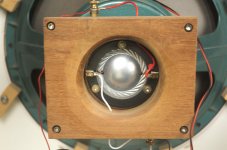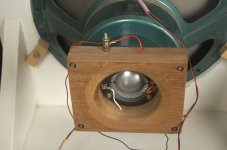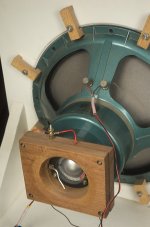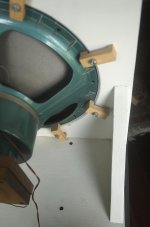Would going active be that noticeable? I’ve done a bit of reading and it seems to be that the most profound gains are made with three ways. With the woofer on the 605 going from ~30-1500hz I’m wondering how much of a difference it would make.
My conceptual starting point is a mic where my head usually is and REW running frequency sweeps. Can I make the FR nice?
There is "active with amp adjustments" and there is "active with lotsa adjustments". You can make an active cover with no controls what so ever mimic your passive crossover exactly as to FR and you will also have the major advantages of dividing the tone compass power in two (or three) and trashing that piece of crude hardware between the amps and the drivers.
Once you get into adjustments (esp DSP*), you can do many wonderful adjustments to make that mic and your ears very happy. Even just exploring other crossover frequencies and slopes - not to mention choosing the power to each driver without needing an awful L-pad - will be an improvement.
Any modern ambitious speaker has like 18 elements in the crossover of each speaker to smooth the response. Are you planning to make the effort to create such a crossover? No fancy manufacturer selling whole-boxes would go to market with the simple xover from the textbook.
B.
*Wouldn't your woofers (and all BR and pseudo-horn boxes) really like to have a sub-sonic cut below 25 Hz (or 40 Hz for pseudo-horns) to keep 'em from flapping about needlessly?
Last edited:
One last question (for now) what cabinet do you have your 604s mounted in?
Onken cabinets.
There is really no need to go active for Altec coax crossovers, and there are some good reasons not to. The passive crossover isn't the easiest you'll ever build, but there are some great designs out there now to serve as starting points. Get it right and you'll have an amazing speaker.
As for the Behringer active crossovers mentioned, I'd only use the DCX2496 and ONLY with a modified output section. Stock it has a "ground glass in mud" sound to it that your 605s will be happy to reveal.
As for the Behringer active crossovers mentioned, I'd only use the DCX2496 and ONLY with a modified output section. Stock it has a "ground glass in mud" sound to it that your 605s will be happy to reveal.
Such as?There is really no need to go active for Altec coax crossovers, and there are some good reasons not to.
This "mud" effect you post every so often never seems to show up in my measurements (or ever in any measurements in the forum devoted to this unit). Nor it is apparent on my laser-crystal-clear electrostatic speakers or fancy headphones.As for the Behringer active crossovers mentioned, I'd only use the DCX2496 and ONLY with a modified output section. Stock it has a "ground glass in mud" sound to it that your 605s will be happy to reveal.
Do you have this unit or can you post measurements or are you just reporting what some people who sell mods for this unit say?
Tens of thousands of happy amateur and professional users for 15 yrs (?) can't all be insensitive to the mud.
B.
You are many years behind the times, Ben. I've posted the measurements here on this very website. And there is a cottage industry of modifying the DCX, for good reason. The digital section is rather nice, the analog section not so much. The power supply can use a little help, but it's nothing major.
Dig a little a Ben, the weakness of the DCX analog section is a known issue and has many flavors of mods. There is a long thread or 3 about them on this forum, as well as across the web. Try some, you'll like 'em.
Dig a little a Ben, the weakness of the DCX analog section is a known issue and has many flavors of mods. There is a long thread or 3 about them on this forum, as well as across the web. Try some, you'll like 'em.
Good reasons NOT to go active with the 604-605.Such as?
- It's just a two way, why bother?
- It's coaxial, no vertical shift to deal with
- It's coaxial, the low pass will put the woofer into phase with the tweeter if you do it right
- You don't need two amps and another line level device
- Easy volume control
- You can play it on any amp you want, if enjoy listening to different amplifiers
- The sound from a single amp can be more coherent than from 2 or 3 (yeah, really)
- Street Cred
- Real men build passive crossovers. Active is for wimps
As the search engine for DIYaudio is challenging for searches of that sort, could you please provide a link or two to your measurements.I've posted the measurements here on this very website.
There are some posts in the electronics forum showing the usual inaudible digital blips and quantizing artefacts in the microsecond vicinity. But nothing that I can recall demonstrating audible issues. Please correct me if there are.
Thanks.
B.
I was hoping you'd do the search work for me.  It's been years ago, I'll see if I can find them.
It's been years ago, I'll see if I can find them.
If you can use the DCX in no filter mode, just as a line level pass thru that you can cut in and out of the signal path, you should be able to heard the difference - that's what I did. I used the tape loop in/out to do that. If you are currently using it as your crossover, that's not going to be easy to do. Don't hear a difference with the DCX inline or out? No worries, no need for upgrades.
If you can use the DCX in no filter mode, just as a line level pass thru that you can cut in and out of the signal path, you should be able to heard the difference - that's what I did. I used the tape loop in/out to do that. If you are currently using it as your crossover, that's not going to be easy to do. Don't hear a difference with the DCX inline or out? No worries, no need for upgrades.

I don't think it is unfair to ask you to support your own claim. I eagerly await the links.I was hoping you'd do the search work for me.It's been years ago, I'll see if I can find them.
Often improvements - like CDs - raise "subjective"* complaints. The real issue is what is the baseline for subjective complaints? In audio - like with CDs - I bet it is like 10%. So if "only" 10% of users say, "... those damn CD take away all the warmth from my recordings....", prolly doesn't count. But if 20% say so, it matters.
I'd say there are .5% complaints about the Behringer DCX2496 and a lot less, if that were possible, for their analog xover.
B.
* or "hard to verify" if you are a measurements person not given to harsh terms
Last edited:
You a funny man!!Good reasons NOT to go active with the 604-605.
- It's just a two way, why bother?
- It's coaxial, no vertical shift to deal with
- It's coaxial, the low pass will put the woofer into phase with the tweeter if you do it right
- You don't need two amps and another line level device
- Easy volume control
- You can play it on any amp you want, if enjoy listening to different amplifiers
- The sound from a single amp can be more coherent than from 2 or 3 (yeah, really)
- Street Cred
- Real men build passive crossovers. Active is for wimps

Read the article, please: BiAmp (Bi-Amplification - Not Quite Magic, But Close) - Part 1 Both parts.
Rod Elliott says it much better than I can. It really is a magical improvement!!
I've read it, and was an active crossover fan-boy for years. But then I began to be more critical - what sounds like "Hi-Fi" and what sounds like real music? Active is seductive for its whiz-bang sound and its speed and ease of hitting the target you want. I know the arguments, I know the sound.
Well implemented passive crossovers just sound more natural to me. Active has all the seduction of Technicolor, it's "more real than real". I don't want to deny anyone their fun, just saying that in 40+ years of listening to active vs passive, I still tend toward passive for pure musicality. I also use active for the whiz-bang and the fun.
Well implemented passive crossovers just sound more natural to me. Active has all the seduction of Technicolor, it's "more real than real". I don't want to deny anyone their fun, just saying that in 40+ years of listening to active vs passive, I still tend toward passive for pure musicality. I also use active for the whiz-bang and the fun.

I use steel core where air core is not practical, or too high DCR. I don't have a problem with them, despite the dire warnings. Maybe because they are rated far above the power I ever throw at them.
You can certainly make a better crossover than the stock Altec, the Markwart crossovers are a very good starting point.
You can certainly make a better crossover than the stock Altec, the Markwart crossovers are a very good starting point.
In response to WBS questions from early in this thread about the open back pieces I made for my 605Bs and my driver mounting method:
1) These three shots show the pieces. Two identical layers of ipe, the back one rounded over to soften the edge (not done for horn effect). The lead wires go through a hole in the front piece and are clamped against the lead from the passive crossover (JB/Pano copy from LASF). It's ring-tongue against ring-tongue.



Taking off the covers on the back of the driver, hence going dipole on the full range made a huge improvemnt. I had heard some cases where guys had cut off the backs of the compression drive part of Hawthorne audio Silver Iris coaxials, turning them from a nice try but . . . to a very good sounding choice.
2)You can see the fingers (little levers) that I use to hold the driver into the recessed back of the baffle. The following image gives a better sense of how they work.

I do it this way because I wanted to use very sturdy bolts/screws to mount the driver. With the back side recess in the baffle and a chamfer on the front, there isn't enough wood for a good anchor where the holes in the driver rim are located. Creating these 'fingers' let me use very sturdy 1/4" hanger bolts into the full thickness of the baffle. Each finger has a small piece of dense, closed cell weather-stripping foam to cushion the contact.
Hope this helps,
Skip
1) These three shots show the pieces. Two identical layers of ipe, the back one rounded over to soften the edge (not done for horn effect). The lead wires go through a hole in the front piece and are clamped against the lead from the passive crossover (JB/Pano copy from LASF). It's ring-tongue against ring-tongue.



Taking off the covers on the back of the driver, hence going dipole on the full range made a huge improvemnt. I had heard some cases where guys had cut off the backs of the compression drive part of Hawthorne audio Silver Iris coaxials, turning them from a nice try but . . . to a very good sounding choice.
2)You can see the fingers (little levers) that I use to hold the driver into the recessed back of the baffle. The following image gives a better sense of how they work.

I do it this way because I wanted to use very sturdy bolts/screws to mount the driver. With the back side recess in the baffle and a chamfer on the front, there isn't enough wood for a good anchor where the holes in the driver rim are located. Creating these 'fingers' let me use very sturdy 1/4" hanger bolts into the full thickness of the baffle. Each finger has a small piece of dense, closed cell weather-stripping foam to cushion the contact.
Hope this helps,
Skip
Thanks for posting Skip! I'm curious how this affects the highs. Does it sound more "open"?
Yes! I didn't try removing the loading caps but leaving on the cover, so no help on that comparison. Once I let the back wave out, it was much nicer. My room does nice things with the back wave because there's a bump out at the front of the house with two short walls at 45 degrees to the rooms rectangle with a short 'square' connector to complete the bump. The result is that a lot of the backwave reflects off the 45 degree wall/windows. Sounds spacious.
Also, being OB with the baffle not much wider than the woofs, do you need a sub to reinforce the bass?
Yes, I have large open-backed boxes with 18" drivers. The Altec baffles sit on the woofer box-baffles. All frequencies come from dipole drivers.
Skip
- Status
- This old topic is closed. If you want to reopen this topic, contact a moderator using the "Report Post" button.
- Home
- Loudspeakers
- Multi-Way
- Altec 605a duplex crossover upgrade